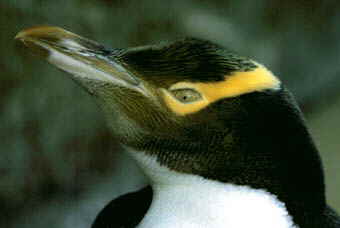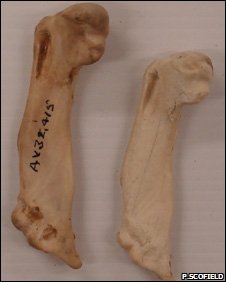New Penguin Discovered: It’s Been Extinct For 500 Years
Posted by: Loren Coleman on November 19th, 2008
Yellow-eyed penguin. Photo by Melanie Massaro.
Ray Lilley of the Associated Press is reporting today from Wellington, New Zealand, that researchers studying a rare and endangered species of penguin have uncovered a previously unknown species that disappeared about 500 years ago. It sounds confusing, so let’s wattle through this together. When I first read the headline and dispatch, I couldn’t tell which species was extinct and which one wasn’t, or even if both were extinct, since fossils of both were being surveyed.
But it is rather straightforward: The Waitaha penguin is a new discovery but extinct; the yellow-eyed penguin is not extinct, but may be soon.
The newly found Waitaha penguin was hunted to extinction by 1500, about 250 years after human’s arrived on the islands (which also wiped out the moas). But the loss of the Waitaha allowed another kind of penguin to thrive — the yellow-eyed species that now also faces extinction, Philip Seddon of Otago University, a co-author of the study, said Wednesday, November 19, 2008.
Here’s how the discovery happened. Seddon’s team was testing DNA from the bones of prehistoric modern yellow-eyed penguins (above) for genetic changes associated with human settlement when it found some bones that were older — and had different DNA.
Tests on the older bones “lead us to describe a new penguin species that became extinct only a few hundred years ago,” the team reported in a paper in the biological research journal Proceedings of the Royal Society B: Biological Sciences.
Eureka! A new penguin that lived in relatively historic times was discovered.
Seddon said dating techniques used on bones pulled from old Maori trash pits revealed a gap in time between the disappearance of the Waitaha and the arrival of the yellow-eyed penguin.
The gap indicates the extinction of the older bird created the opportunity for the newer to colonize New Zealand’s main islands around 500 years ago, said Sanne Boessenkool, an Otago University doctoral student who led the team of researchers, including some from Australia’s Adelaide University and New Zealand’s Canterbury Museum.
Competition between the two penguin species may have previously prevented the yellow-eyed penguin from expanding north, the researchers noted.
It is vitally important to know how species, such as the yellow-eyed penguin, are able to respond to new opportunities. It is becoming apparent that some species can respond to things like climate change, and others cannot. The more we know, the more we can help. David Penny, Massey University, New Zealand.
The yellow-eyed penguin is bigger than its extinct relative. The yellow-eyed penguin is considered one of the world’s rarest. An estimated population of 7,000 in New Zealand is the focus of an extensive conservation effort.
According to the BBC, the new species has been named Megadyptes waitaha. The Waitaha were the first Polynesian tribe to occupy South Island.
M. waitaha’s rapid replacement by its close relative the yellow eyed penguin, Megadyptes antipodies, raises questions about current dating techniques and extinction theories, says Sanne Boessenkool.
“Often when we look back in time and date bones we don’t think a couple of hundred years is important, but here you get a complete shift in just a couple of hundred years. These patterns might be more common, a view we don’t consider when looking at large scale extinction events,” she explained.
By the time Europeans arrived in South Island in the 1800s, the yellow-eyed penguins had already taken over the sites left by its relative. The bird’s breeding behaviour makes it an unlikely colonizer. Sanne BoessenKool has studied them in the field for many years.
“They are very secretive, shy and difficult to monitor, they don’t live in big colonies, but build their own nest perhaps under some bushes,” she commented.
Despite their fragile foothold the researchers say these incoming penguins probably survived on New Zealand’s South Island due to a change in human behavior.
Either the human settlers moved further north due to a lack of food following the extinction of the earlier penguins and other species, or they had begun to develop some of the conservation principles found in contemporary Maori culture and so saw a need to allow these penguins to survive.
Sanne Boessenkool is now investigating how and when the penguins moved across from the sub-Antarctic Auckland and Campbell islands.
“It is a mystery, were now looking at the ways it may have colonised, if its a small group or if they are still coming,” she said.
About Loren Coleman
Loren Coleman is one of the world’s leading cryptozoologists, some say “the” leading living cryptozoologist. Certainly, he is acknowledged as the current living American researcher and writer who has most popularized cryptozoology in the late 20th and early 21st centuries.
Starting his fieldwork and investigations in 1960, after traveling and trekking extensively in pursuit of cryptozoological mysteries, Coleman began writing to share his experiences in 1969. An honorary member of Ivan T. Sanderson’s Society for the Investigation of the Unexplained in the 1970s, Coleman has been bestowed with similar honorary memberships of the North Idaho College Cryptozoology Club in 1983, and in subsequent years, that of the British Columbia Scientific Cryptozoology Club, CryptoSafari International, and other international organizations. He was also a Life Member and Benefactor of the International Society of Cryptozoology (now-defunct).
Loren Coleman’s daily blog, as a member of the Cryptomundo Team, served as an ongoing avenue of communication for the ever-growing body of cryptozoo news from 2005 through 2013. He returned as an infrequent contributor beginning Halloween week of 2015.
Coleman is the founder in 2003, and current director of the International Cryptozoology Museum in Portland, Maine.













amazing.. Let’s hope for a colossal penguin